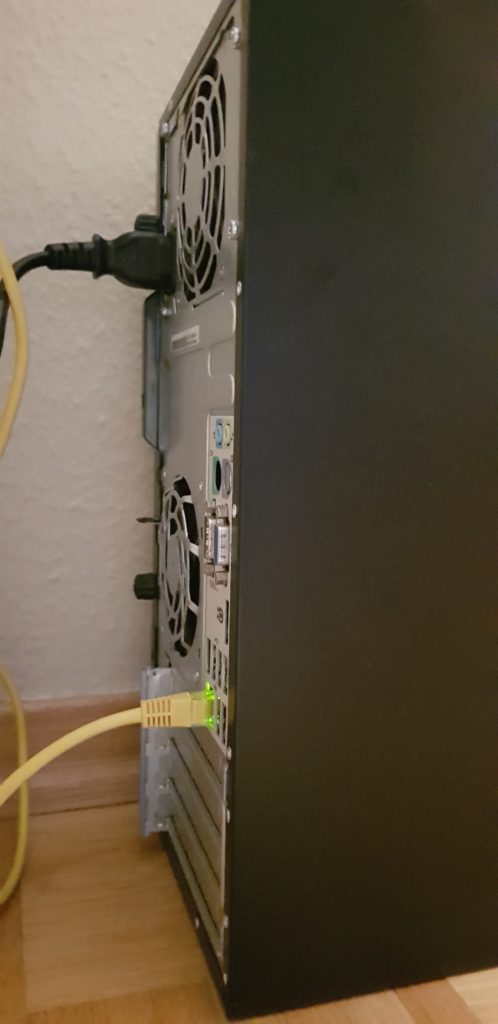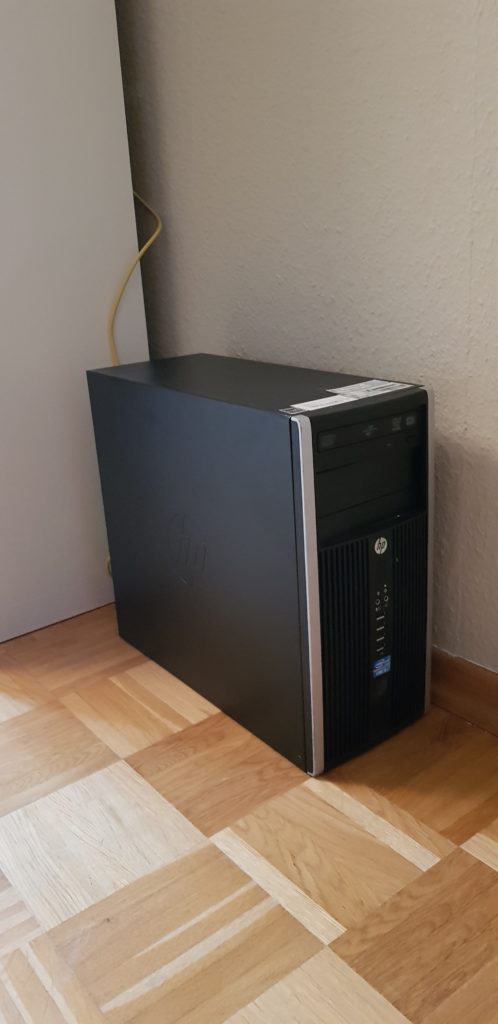The idea to set up our homepage on our own server came to me after reading Edward Snowden’s new autobiography. In the initial chapters, there is quite a lot of nostalgia about the early days of the internet (you know, AltaVista, Netscape Navigator and the sort). Most importantly, the days before social networking sites. Back then, the internet was a friendly community of computer enthusiasts from around the world (amateurs and professionals alike), and everyone who was anyone in this scene had to have their own homepage. Hosting our homepage on our very own server has the extra appeal of being in control of my own data… something that is harder and harder to achieve in this day and age.
So, if you are reading this, it is finally up and running. Our very own server, gently humming in our second bedroom, no display, no keyboard. Just the old aluminum tower connected by one cord to power and by another to our FritzBox Router. She is an old HP-Compaq office workstation I got off Ebay for 85 EUR (Corei5, 8GB RAM, 500GB HDD).

Power and Internet – what more do you need? 
Dedicated Server for EUR 85
Setting up your own server is a very fun project that I can recommend to anyone, who enjoys tweaking computers. It is easy enough to do for amateurs, with ample support available through forums in the net. Do expect to waste a couple of weekends, until everything is ready 🙂
This has been a low cost project, because all the software I am using is open-source. Praise the very motivated internet community out there! After the installation of the operating system, you can communicate with your server using your other PCs or macs, so you can disconnect the monitor and keyboard and move the server into a corner, where it won’t be in the way.
Your server will need some configuration and the installation of software best suited to your purposes, but there is a lot of help to be found in online forums (I can especially recommend the tutorials of digitalocean.com). I am not going to name all of the software I am using (security reasons), except for one. This is the “5 minute installation package” from wordpress.org. WordPress also provides payed web hosting and web design tools, but their DIY kit is completely free. This is the tool that really fires up the engines and turns your site into a 21st century web page. Even though the installation did take a bit longer (a few hours, not 5 minutes), I suppose if you know what you are doing, it can actually be done a lot faster. After you have installed it, you can edit your website through any browser in a completely modern, graphical interface. You can find templates that you can customize to best fit your needs. Very cool stuff.
Depending on your internet service provider (ISP) it may be difficult to make your server reachable through the internet. There is a process called port forwarding on your router, that should enable outside access to your server, based on its IP address. This is a long and seemingly random number that no one can or wants to remember, which is why you need to register for a service called dynamic DNS (DDNS). This is a very cheap (in my case 8 cents a month) service, where you register for a domain of your choice (ilonagabor.de). The service provider maintains a registry, linking your domain to the IP address, so that people can reach your server by typing your domain into their browsers. Neat 🙂
On a side note, the world is apparently running out of IP addresses (like 25.74.125.95), since this system called IPv4 only allows for about 3 billion combinations. A new system named IPv6 exists to bypass this, with even longer IP addresses involving numbers and letters divided by colons. Most ISPs, mine included, don’t provide you with your very own IPv4 address anymore, which really only becomes a problem if you want to set up a server. I managed to find a way using the IPv6 address, however some German ISPs don’t yet support this standard, which is why some of my friends can’t (yet) access our web site. Bummer. I will try to come up with a workaround in the near future.
I took a lot of care to set up our server to be reasonably safe. I am not naive enough to think that we are safe from any hacker attack. But the current setup should be secure enough for any hacker not to want to bother, considering the trivial nature of our content. At any rate, there is a backup system in place so if things go south (or say the old PC throws in the towel) I should be able to get things up and running again pretty fast.
Ilona can confirm this: I was pretty proud when at 2 am this morning, the website was finally online, with everything in place at https://ilonagabor.de, fresh and beautiful as expected 🙂 All in all – well worth the effort!
P.s.: I will be happy to provide more details on the set up. Just drop me an e-mail to gabord@pm.me. Next project: self hosted e-mails! Coming soon…

Update: IP issue solved for us by the nice people at our ISP. Our site is now accessible to the broad public on the internet (IPv4 and IPv6).